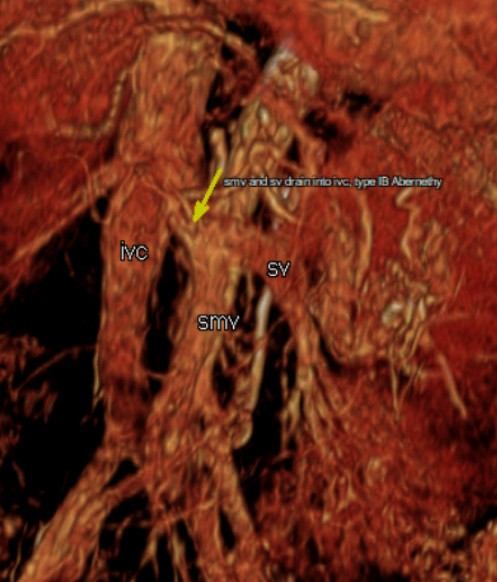Sunday Poster Session
Category: Liver
P1724 - Type IB Abernethy Malformation in Adult With VACTERL Association
Sunday, October 26, 2025
3:30 PM - 7:00 PM PDT
Location: Exhibit Hall

Shravya R. Ginnaram, MD
University of Nebraska Medical Center
Ocala, FL
Presenting Author(s)
Shravya R. Ginnaram, MD, Katerina Roma, DO, Pratiksha Moliya, MD, Omid Sanaei, MD, Faruq Pradhan, MBBCh
University of Nebraska Medical Center, Omaha, NE
Introduction: Congenital extrahepatic portosystemic shunt (CEPS), or Abernethy malformation, is a rare vascular anomaly where splanchnic blood bypasses the liver and drains directly into systemic circulation. Classified by Morgan and Superina, type 1 involves absent intrahepatic portal veins, while type 2 retains hypoplastic branches. Type 1A and 1B differ in how the mesenteric and splenic veins drain into the IVC. CEPS may present with hepatopulmonary syndrome, metabolic dysfunction, hepatic encephalopathy, or pulmonary hypertension, and is often diagnosed by imaging. It is also associated with congenital heart defects due to shared embryologic origins.
Case Description/
Methods: 48/M with VACTERL association including Tetralogy of Fallot, pulmonic stenosis, tracheoesophageal fistula, solitary right kidney, scoliosis, and provoked pulmonary embolism presented with generalized weakness, fatigue, early satiety, and significant weight loss. He was diagnosed with subacute prosthetic pulmonary valve endocarditis and treated with antibiotics and steroids for presumed ANCA associated vasculitis, supported by elevated PR3 and low C3 and C4 levels. Laboratory studies showed elevated AST 103 U/L, ALT 117 U/L, and total bilirubin 4.4 mg/dL. Doppler ultrasound revealed a nodular liver, absent portal vein flow, and extensive collateral circulation with an enlarged spleen and hyperdynamic hepatic artery, raising concern for chronic portal vein thrombosis. MRCP revealed a type IB Abernethy malformation with a common trunk from the splenic and superior mesenteric veins draining into the IVC. A small right hepatic vessel represented a rudimentary right portal vein, with no main or left portal veins and no thrombosis, confirming a congenital anomaly.
Discussion: CEPS results from failed remodeling of the vitelline veins between gestational weeks four and ten, leading to anomalous drainage and absent portal flow. The association with cardiac, renal, and gastrointestinal anomalies reflects a shared mesodermal disruption. Clinically, CEPS exposes the systemic circulation to gut derived toxins, bypassing hepatic clearance. Complications include hyperammonemia, hepatic encephalopathy, hepatopulmonary syndrome, portopulmonary hypertension, and hepatic tumors. Some patients with CEPS remain asymptomatic due to partial hepatic perfusion, metabolic adaptation, or absence of triggering factors, leading to delayed or incidental diagnosis. Accurate diagnosis guides management, including possible liver transplantation in type I cases.

Figure: Type IB Abernethy malformation: A common trunk formed by the splenic vein and SMV drains into the IVC. No main or left portal vein is seen; a small vessel in the right lobe functions as a right portal vein, draining into the common trunk.
Disclosures:
Shravya Ginnaram indicated no relevant financial relationships.
Katerina Roma indicated no relevant financial relationships.
Pratiksha Moliya indicated no relevant financial relationships.
Omid Sanaei indicated no relevant financial relationships.
Faruq Pradhan: Ipsen Biopharmaceuticals – Advisory Committee/Board Member. Madrigal Pharmaceuticals – Advisory Committee/Board Member.
Shravya R. Ginnaram, MD, Katerina Roma, DO, Pratiksha Moliya, MD, Omid Sanaei, MD, Faruq Pradhan, MBBCh. P1724 - Type IB Abernethy Malformation in Adult With VACTERL Association, ACG 2025 Annual Scientific Meeting Abstracts. Phoenix, AZ: American College of Gastroenterology.
University of Nebraska Medical Center, Omaha, NE
Introduction: Congenital extrahepatic portosystemic shunt (CEPS), or Abernethy malformation, is a rare vascular anomaly where splanchnic blood bypasses the liver and drains directly into systemic circulation. Classified by Morgan and Superina, type 1 involves absent intrahepatic portal veins, while type 2 retains hypoplastic branches. Type 1A and 1B differ in how the mesenteric and splenic veins drain into the IVC. CEPS may present with hepatopulmonary syndrome, metabolic dysfunction, hepatic encephalopathy, or pulmonary hypertension, and is often diagnosed by imaging. It is also associated with congenital heart defects due to shared embryologic origins.
Case Description/
Methods: 48/M with VACTERL association including Tetralogy of Fallot, pulmonic stenosis, tracheoesophageal fistula, solitary right kidney, scoliosis, and provoked pulmonary embolism presented with generalized weakness, fatigue, early satiety, and significant weight loss. He was diagnosed with subacute prosthetic pulmonary valve endocarditis and treated with antibiotics and steroids for presumed ANCA associated vasculitis, supported by elevated PR3 and low C3 and C4 levels. Laboratory studies showed elevated AST 103 U/L, ALT 117 U/L, and total bilirubin 4.4 mg/dL. Doppler ultrasound revealed a nodular liver, absent portal vein flow, and extensive collateral circulation with an enlarged spleen and hyperdynamic hepatic artery, raising concern for chronic portal vein thrombosis. MRCP revealed a type IB Abernethy malformation with a common trunk from the splenic and superior mesenteric veins draining into the IVC. A small right hepatic vessel represented a rudimentary right portal vein, with no main or left portal veins and no thrombosis, confirming a congenital anomaly.
Discussion: CEPS results from failed remodeling of the vitelline veins between gestational weeks four and ten, leading to anomalous drainage and absent portal flow. The association with cardiac, renal, and gastrointestinal anomalies reflects a shared mesodermal disruption. Clinically, CEPS exposes the systemic circulation to gut derived toxins, bypassing hepatic clearance. Complications include hyperammonemia, hepatic encephalopathy, hepatopulmonary syndrome, portopulmonary hypertension, and hepatic tumors. Some patients with CEPS remain asymptomatic due to partial hepatic perfusion, metabolic adaptation, or absence of triggering factors, leading to delayed or incidental diagnosis. Accurate diagnosis guides management, including possible liver transplantation in type I cases.

Figure: Type IB Abernethy malformation: A common trunk formed by the splenic vein and SMV drains into the IVC. No main or left portal vein is seen; a small vessel in the right lobe functions as a right portal vein, draining into the common trunk.
Disclosures:
Shravya Ginnaram indicated no relevant financial relationships.
Katerina Roma indicated no relevant financial relationships.
Pratiksha Moliya indicated no relevant financial relationships.
Omid Sanaei indicated no relevant financial relationships.
Faruq Pradhan: Ipsen Biopharmaceuticals – Advisory Committee/Board Member. Madrigal Pharmaceuticals – Advisory Committee/Board Member.
Shravya R. Ginnaram, MD, Katerina Roma, DO, Pratiksha Moliya, MD, Omid Sanaei, MD, Faruq Pradhan, MBBCh. P1724 - Type IB Abernethy Malformation in Adult With VACTERL Association, ACG 2025 Annual Scientific Meeting Abstracts. Phoenix, AZ: American College of Gastroenterology.
